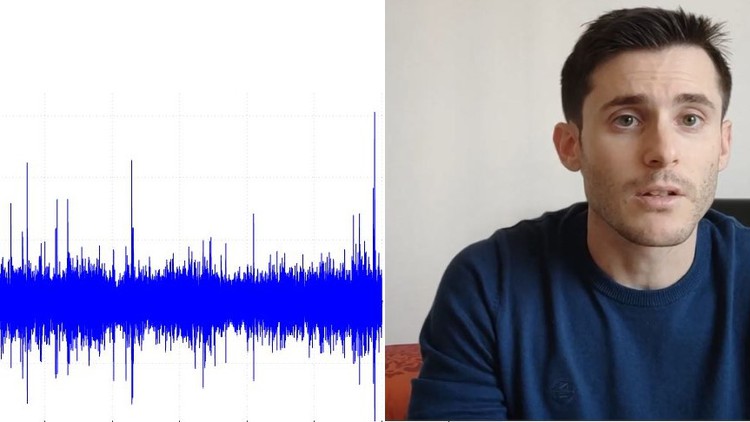The Math of Random Signals, Fatigue Damage, Vibration Tests
- Description
- Curriculum
- FAQ
- Reviews
Ready to Learn About the Fascinating World of Fatigue Damage and Its Application in Engineering ?
1: Introduction
Are you interested in learning about fatigue damage and its application in engineering? If so, enroll in this comprehensive course and delve deep into the mathematics of fatigue damage, from the derivation of essential equations to the application of the theory in real-life situations.
2: Course Objectives
This course is designed for anyone interested in vibration tests and reliability engineering, as well as those who want to see the beauty of mathematics applied to engineering. You will learn about stochastic processes, probability distributions, and their role in real-life applications, as well as single-degree-of-freedom systems, the probability density of the maxima of a random process, and much more.
3: Instructor Expertise
The concepts in this course are based on the instructor’s PhD dissertation: “Advanced Mission Synthesis Algorithms for Vibration-based Accelerated Life-testing,” which has been publicly available since February 2023 after a two-year “embargo”, because the algorithms contained therein, could not be disclosed.
You will also have access to Graphical User Interfaces (GUI) developed by the instructor in collaboration with companies interested in the PhD project to see how equations can be implemented to generate vibratory signals.
4: Course Structure
This course will introduce you to fatigue-life estimation tests that aim to reproduce the entire fatigue damage experienced by the component during its operational life, but in a shorter amount of time. You will learn about how to tailor these tests to specific applications and generate signals that have the same “damage potential” as the environmental conditions to which the components are subjected.
5: Benefits of the Course
By enrolling in this course, you will gain advanced mathematical concepts that are intuitive to understand, and the connection to real-life applications will always be highlighted. You will learn how to relate a Power Spectral Density (PSD) to the fatigue damage, which is essential for creating signals to be used during tests. Additionally, you will learn about non-Gaussian signals, which are important since there are signals measured in real-life applications that show a deviation from the Gaussian distribution due to the presence of peaks and bursts in the signals.
6: Course Content
The course content includes:
– Introduction to fatigue damage
– Stochastic processes and probability distributions
– Single-degree-of-freedom systems
– Probability density of the maxima of a random process
– Tailoring fatigue-life estimation tests to specific applications
– Generating signals with the same “damage potential” as environmental conditions
– Relating Power Spectral Density (PSD) to fatigue damage
– Creating Gaussian and non-Gaussian signals
7: Course Delivery
This course is available online and can be accessed at any time, from anywhere in the world. You will have access to instructional videos, but also reading materials (my PhD dissertation), to deepen your understanding if necessary.
8: Course Duration
The course duration is flexible and self-paced, allowing you to learn at your own pace. It is estimated that the course will take around 10-12 hours to complete ( even though it lasts less, but you need time to think !!! 🙂 )
9: Course Completion
Upon completion of this course, you will receive a certificate of completion, which can be used to demonstrate your knowledge and skills in the field of fatigue damage and its application in vibration testing.
10: Who is this course for?
This course is for anyone interested in learning about fatigue damage and its application in engineering, including engineering students, professionals, and anyone with a love for mathematics and its applications.
Enroll today and start exploring the fascinating world of fatigue damage!
-
1Introduction to the courseVideo lesson
-
2Joint Gaussian DistributionVideo lesson
-
3Probability Distribution of the Envelope of a Gaussian Signal (Rayleigh distrib)Video lesson
-
4Mathematical Definition of Fatigue damageVideo lesson
-
5Formula for the Expected number of Positive PeaksVideo lesson
-
6Power Spectral Density, Standard Deviation of a Random Process & its DerivativesVideo lesson
-
7Relating the Fatigue Damage Spectrum to the Power Spectral DensityVideo lesson
-
8Practical Explanation on How to Calculate the Fatigue Damage SpectrumVideo lesson
-
9Maximum Response SpectrumVideo lesson
-
10Practical use of the theory of Fatigue DamageVideo lesson
-
11Algorithms for the Calculation of the Power Spectral DensityVideo lesson
-
12How to Create Non-Gaussian Signals with a Prescribed Fatigue Damage SpectrumVideo lesson
-
13Application: Synthesis of Non-Gaussian Signals with a Prescribed Fatigue DamageVideo lesson
-
14Application of the Maximum Response SpectrumVideo lesson
-
15How the Central Limit Theorem Arises from Stochastic ProcessesVideo lesson
-
16Integral of Even Powers of SinusoidsVideo lesson
-
17Some Representations of the Bessel function of Order ZeroVideo lesson
-
18Probability Density of a SinusoidVideo lesson
-
19Distribution of a Sinusoid Derived IntuitivelyVideo lesson
-
20Why a Random Signal with Uniformly Distributed Phases is GaussianVideo lesson
-
23Introduction to Stochastic ProcessesVideo lesson
-
24Derivation of the Properties of a Linear SystemVideo lesson
-
25Properties of the Fourier Transform of a Real Time SignalVideo lesson
-
26Fourier Series Representation of the Output of a Linear SystemVideo lesson
-
27Another Useful Representation of the Fourier SeriesVideo lesson
-
28Recalling the Relationship Between the Fourier Series and the Fourier TransformVideo lesson

External Links May Contain Affiliate Links read more





